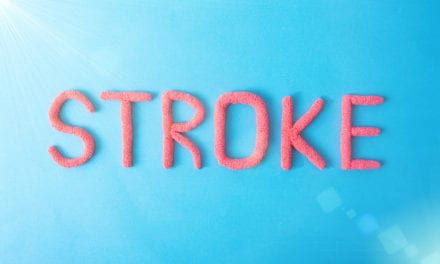Envision a middle-aged woman sitting in a wheelchair who is paralyzed except for the ability to tilt her head and move her eyes. Extending from the top of her head is a plug, with a cord running from it to a computer linked to a monitor. On the monitor screen is a display of a standard QWERTY keyboard. Silently a cursor moves across the keyboard. Asked how she likes using this system, she deliberately picks out the letters E-X-C-I-T-I-N-G. Amazingly, she does this just by thinking of her hand controlling and clicking an imaginary mouse.
The device that links the brain of this stroke survivor to a computer and restores her ability to communicate with the world is called BrainGate2, and its development is the pioneering work of a team of researchers funded by the National Institute on Deafness and Other Communication Disorders (NIDCD), the National Institutes of Health (NIH), and the Department of Veterans Affairs (VA). They are using what’s known as brain-computer interface technology to turn thoughts into words by recording signals in the brain that normally direct movement and then using computer programs to turn those signals into actions.
Locked-in syndrome is a state of near-total paralysis that happens as a result of injury or brain degeneration when the link has been broken between the movement centers of the brain, including the motor cortex, and the rest of the body. It can happen after brain-stem stroke or traumatic brain injury and can also be a long-term consequence of neuromuscular disease, such as amyotrophic lateral sclerosis (ALS, or Lou Gehrig’s disease). People with locked-in syndrome are still vibrantly alive in their minds, with the ability to think and feel. But without movement or speech, there is currently very little they can do to communicate with the world.
BrainGate2 is the brainchild of a group of neuroscientists and neuroengineers based at Brown University in Providence, RI. NIDCD grantee Leigh Hochberg, MD, PhD, affiliated with Brown and the VA Medical Center in Providence, and Massachusetts General Hospital and Harvard Medical School in Boston, leads the effort to make this investigational technology a communication tool for the locked-in. Without even moving an eyelid, someone with locked-in syndrome only has to imagine moving his or her hand on a computer mouse to make the cursor move on the computer screen.
Hochberg says that this clinical trial of BrainGate2 wouldn’t be possible without NIH’s neural prostheses programs that allows the brain to interact directly with a computer. BrainGate2 is ultimately the result of the accumulation of knowledge from 40 years of NIH- and VA-sponsored research into the activities of the motor cortex, an area at the top of the brain, which is important in controlling body movement.
Hochberg’s team had to overcome several hurdles to bring their device to life. Among them was developing a method to “decode” action potentials, brief pulses or firings of electrical energy, which the brain uses to transmit information between and among neurons. Using a mathematical algorithm and computer software, it became possible to translate the neuronal activity of the motor cortex into clear directional signals.
Another challenge was showing that the signals in the motor cortex that generate movement remain intact, even after the connection between the brain and the muscles is lost. It has been common wisdom in neurophysiology circles that the brain operates on a kind of “use it or lose it” basis, so that neural circuits that aren’t used regularly often reorganize or take on a different purpose. But Hochberg and his team have found familiar patterns and strengths of motor cortex signals in people who have participated in their study, regardless of how long ago they had been injured.
So, if the signals were still strong and programs could be written to decode them, hooking up the brain to the computer could unlock the locked-in and allow them to communicate again.
The hardware of BrainGate2 is relatively simple. A tiny implanted microarray sensor records the activity of dozens to a hundred or more neurons in real time and transmits them to a plug attached to the scalp. These signals travel to a computer, which is programmed to translate them into the movement of a cursor on the monitor screen. “The signals are the same signals that would have ordinarily controlled movement of the arm or the hand,” said Hochberg, “and now they’ve been harnessed to control an imagined computer mouse.”
Right now the equipment is cumbersome and the only people who can use it are the pioneering participants who have been enrolled in the study and, even then, only when someone is there to turn the system on. “It’s about at the same stage as the first heart pacemaker, when you pushed it along in front of you on a cart,” said Hochberg. But he said that will change as the device is refined, miniaturized, and fully implanted in the motor cortex where it can beam information to the computer using wireless technology.
[Source:[removed] NIDCD[/removed]]



